Leadership & Performance: Transformational Leadership Approach
VerifiedAdded on 2023/06/12
|8
|1807
|497
Report
AI Summary
This report examines the critical role of leadership in organizational performance, focusing on transformational leadership as a key strategy. It discusses how leaders can establish a clear vision, motivate employees, and foster a competitive environment to enhance organizational outcomes. The report explores different approaches to measuring organizational performance and emphasizes the positive relationship between transformational leadership and both individual and organizational success. Ultimately, it concludes that organizations should prioritize transformational leadership to ensure continued growth and sustainability. Desklib offers a platform for students to access this and similar solved assignments.
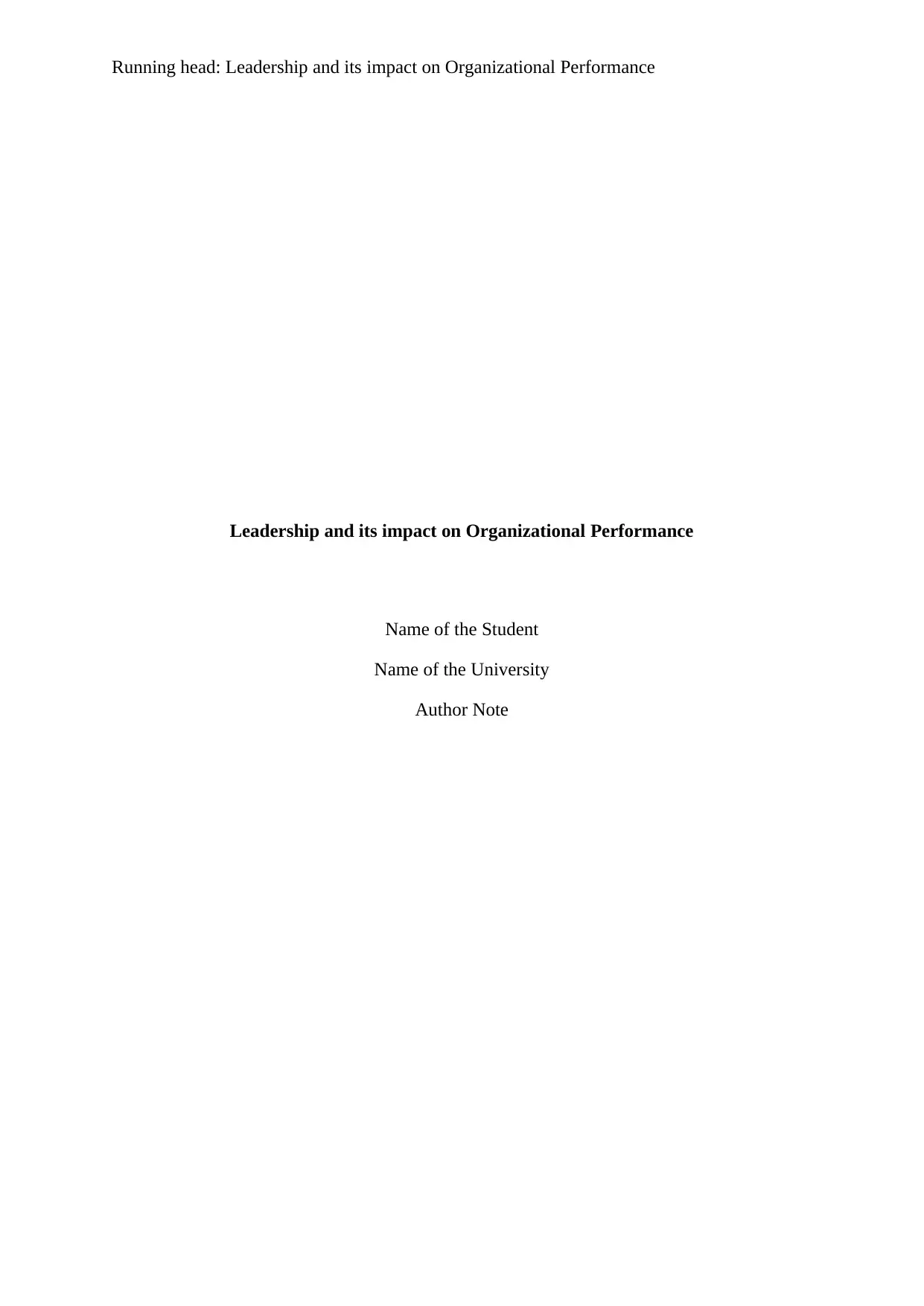
Running head: Leadership and its impact on Organizational Performance
Leadership and its impact on Organizational Performance
Name of the Student
Name of the University
Author Note
Leadership and its impact on Organizational Performance
Name of the Student
Name of the University
Author Note
Paraphrase This Document
Need a fresh take? Get an instant paraphrase of this document with our AI Paraphraser
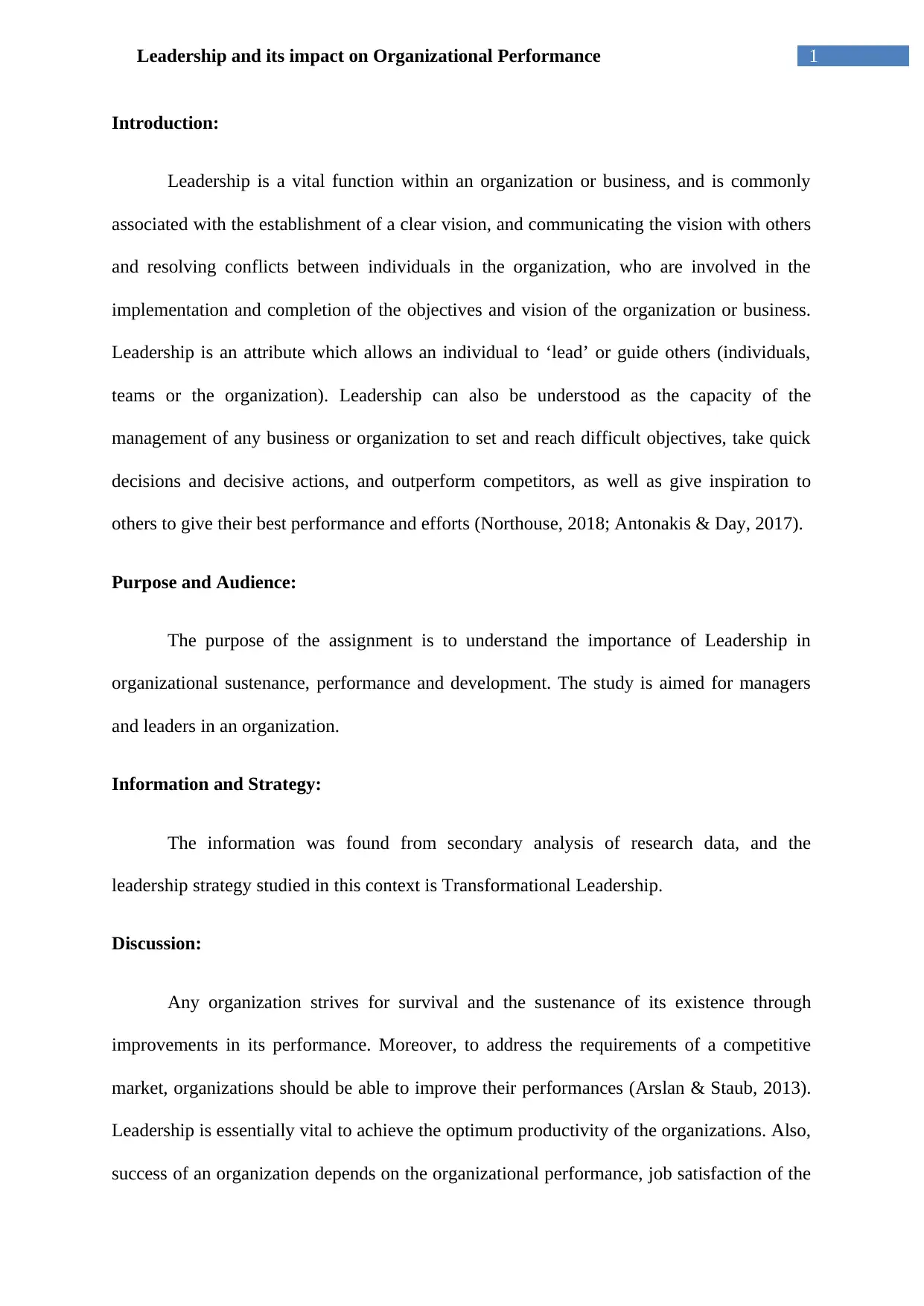
1Leadership and its impact on Organizational Performance
Introduction:
Leadership is a vital function within an organization or business, and is commonly
associated with the establishment of a clear vision, and communicating the vision with others
and resolving conflicts between individuals in the organization, who are involved in the
implementation and completion of the objectives and vision of the organization or business.
Leadership is an attribute which allows an individual to ‘lead’ or guide others (individuals,
teams or the organization). Leadership can also be understood as the capacity of the
management of any business or organization to set and reach difficult objectives, take quick
decisions and decisive actions, and outperform competitors, as well as give inspiration to
others to give their best performance and efforts (Northouse, 2018; Antonakis & Day, 2017).
Purpose and Audience:
The purpose of the assignment is to understand the importance of Leadership in
organizational sustenance, performance and development. The study is aimed for managers
and leaders in an organization.
Information and Strategy:
The information was found from secondary analysis of research data, and the
leadership strategy studied in this context is Transformational Leadership.
Discussion:
Any organization strives for survival and the sustenance of its existence through
improvements in its performance. Moreover, to address the requirements of a competitive
market, organizations should be able to improve their performances (Arslan & Staub, 2013).
Leadership is essentially vital to achieve the optimum productivity of the organizations. Also,
success of an organization depends on the organizational performance, job satisfaction of the
Introduction:
Leadership is a vital function within an organization or business, and is commonly
associated with the establishment of a clear vision, and communicating the vision with others
and resolving conflicts between individuals in the organization, who are involved in the
implementation and completion of the objectives and vision of the organization or business.
Leadership is an attribute which allows an individual to ‘lead’ or guide others (individuals,
teams or the organization). Leadership can also be understood as the capacity of the
management of any business or organization to set and reach difficult objectives, take quick
decisions and decisive actions, and outperform competitors, as well as give inspiration to
others to give their best performance and efforts (Northouse, 2018; Antonakis & Day, 2017).
Purpose and Audience:
The purpose of the assignment is to understand the importance of Leadership in
organizational sustenance, performance and development. The study is aimed for managers
and leaders in an organization.
Information and Strategy:
The information was found from secondary analysis of research data, and the
leadership strategy studied in this context is Transformational Leadership.
Discussion:
Any organization strives for survival and the sustenance of its existence through
improvements in its performance. Moreover, to address the requirements of a competitive
market, organizations should be able to improve their performances (Arslan & Staub, 2013).
Leadership is essentially vital to achieve the optimum productivity of the organizations. Also,
success of an organization depends on the organizational performance, job satisfaction of the
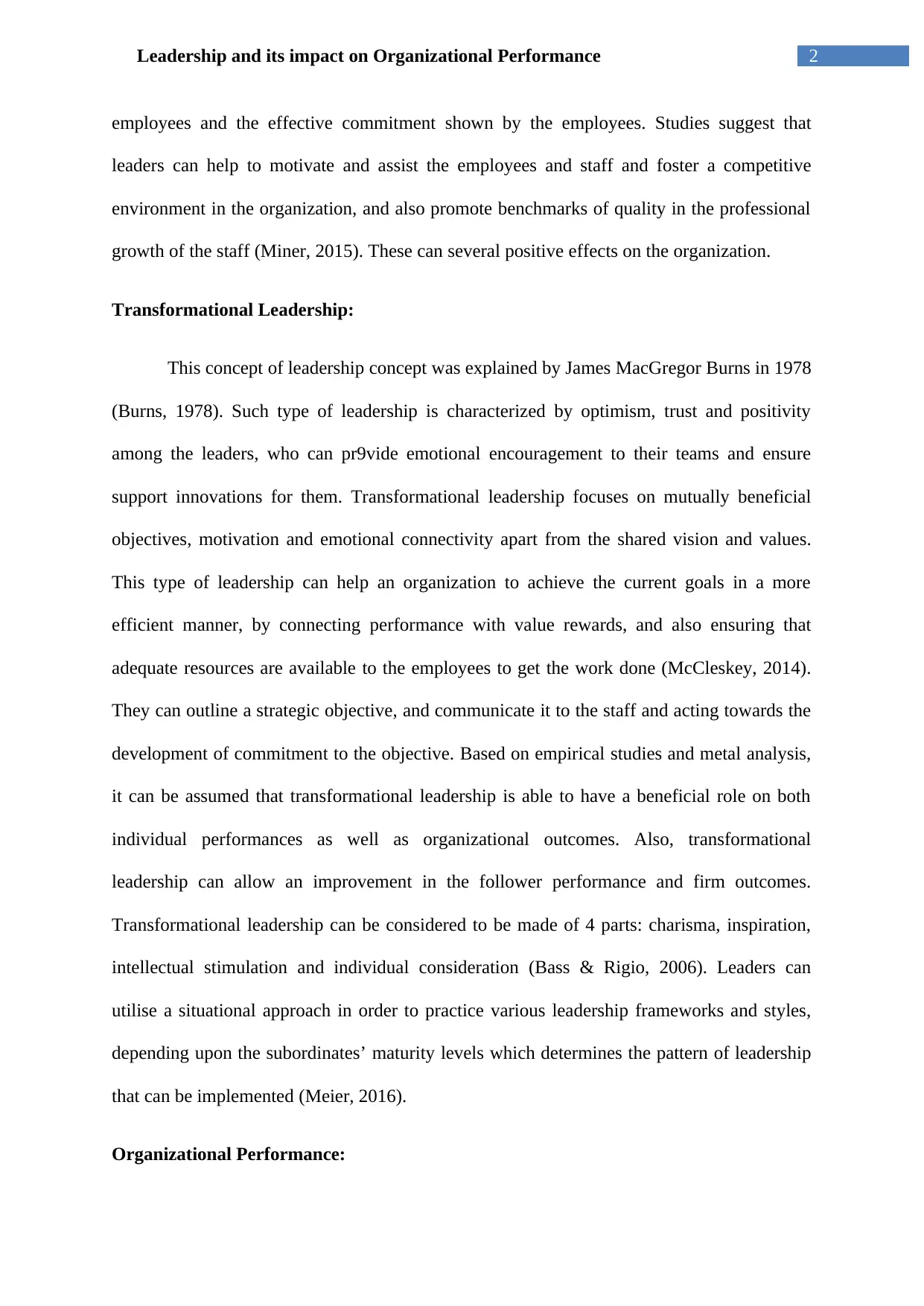
2Leadership and its impact on Organizational Performance
employees and the effective commitment shown by the employees. Studies suggest that
leaders can help to motivate and assist the employees and staff and foster a competitive
environment in the organization, and also promote benchmarks of quality in the professional
growth of the staff (Miner, 2015). These can several positive effects on the organization.
Transformational Leadership:
This concept of leadership concept was explained by James MacGregor Burns in 1978
(Burns, 1978). Such type of leadership is characterized by optimism, trust and positivity
among the leaders, who can pr9vide emotional encouragement to their teams and ensure
support innovations for them. Transformational leadership focuses on mutually beneficial
objectives, motivation and emotional connectivity apart from the shared vision and values.
This type of leadership can help an organization to achieve the current goals in a more
efficient manner, by connecting performance with value rewards, and also ensuring that
adequate resources are available to the employees to get the work done (McCleskey, 2014).
They can outline a strategic objective, and communicate it to the staff and acting towards the
development of commitment to the objective. Based on empirical studies and metal analysis,
it can be assumed that transformational leadership is able to have a beneficial role on both
individual performances as well as organizational outcomes. Also, transformational
leadership can allow an improvement in the follower performance and firm outcomes.
Transformational leadership can be considered to be made of 4 parts: charisma, inspiration,
intellectual stimulation and individual consideration (Bass & Rigio, 2006). Leaders can
utilise a situational approach in order to practice various leadership frameworks and styles,
depending upon the subordinates’ maturity levels which determines the pattern of leadership
that can be implemented (Meier, 2016).
Organizational Performance:
employees and the effective commitment shown by the employees. Studies suggest that
leaders can help to motivate and assist the employees and staff and foster a competitive
environment in the organization, and also promote benchmarks of quality in the professional
growth of the staff (Miner, 2015). These can several positive effects on the organization.
Transformational Leadership:
This concept of leadership concept was explained by James MacGregor Burns in 1978
(Burns, 1978). Such type of leadership is characterized by optimism, trust and positivity
among the leaders, who can pr9vide emotional encouragement to their teams and ensure
support innovations for them. Transformational leadership focuses on mutually beneficial
objectives, motivation and emotional connectivity apart from the shared vision and values.
This type of leadership can help an organization to achieve the current goals in a more
efficient manner, by connecting performance with value rewards, and also ensuring that
adequate resources are available to the employees to get the work done (McCleskey, 2014).
They can outline a strategic objective, and communicate it to the staff and acting towards the
development of commitment to the objective. Based on empirical studies and metal analysis,
it can be assumed that transformational leadership is able to have a beneficial role on both
individual performances as well as organizational outcomes. Also, transformational
leadership can allow an improvement in the follower performance and firm outcomes.
Transformational leadership can be considered to be made of 4 parts: charisma, inspiration,
intellectual stimulation and individual consideration (Bass & Rigio, 2006). Leaders can
utilise a situational approach in order to practice various leadership frameworks and styles,
depending upon the subordinates’ maturity levels which determines the pattern of leadership
that can be implemented (Meier, 2016).
Organizational Performance:
⊘ This is a preview!⊘
Do you want full access?
Subscribe today to unlock all pages.

Trusted by 1+ million students worldwide
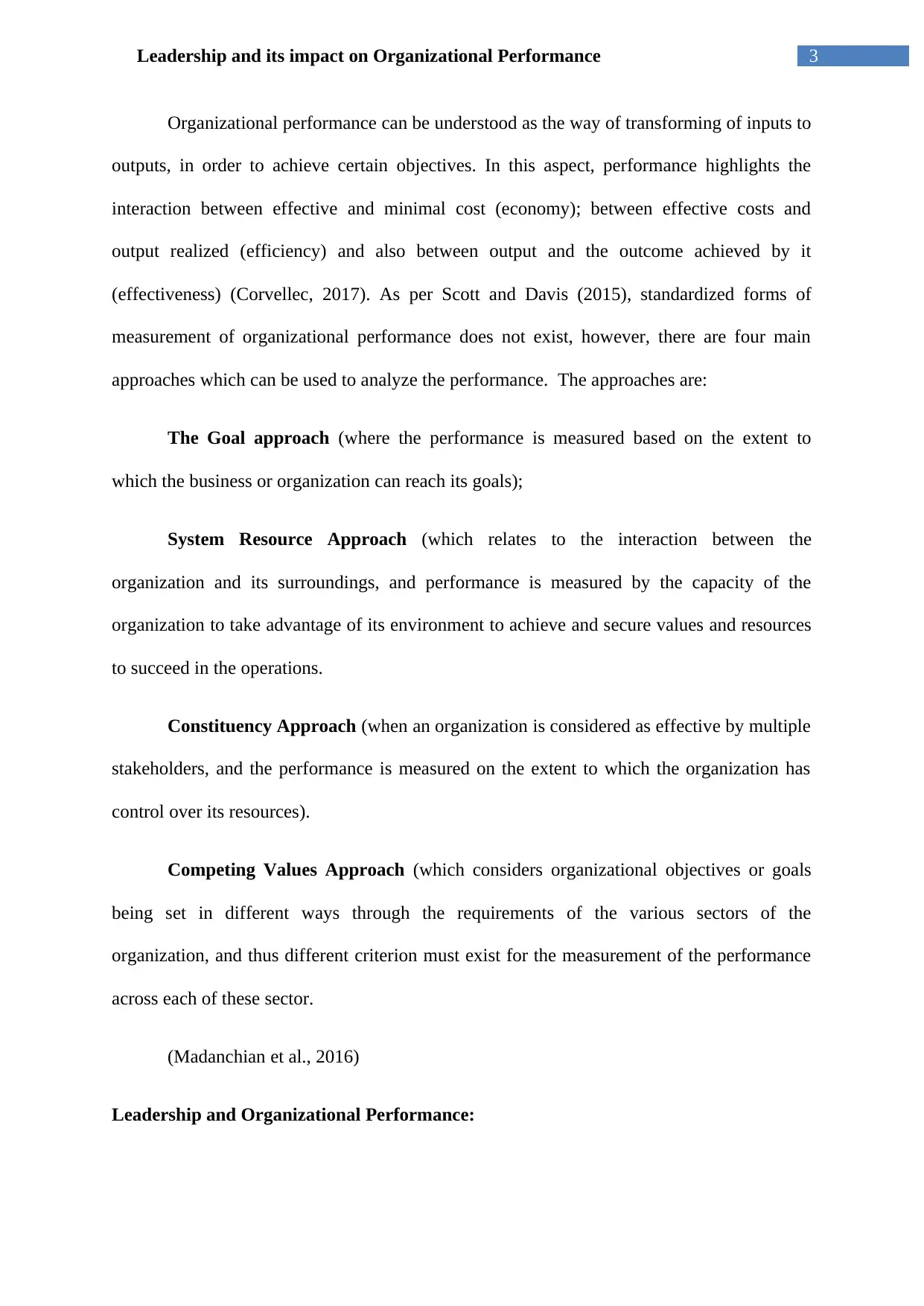
3Leadership and its impact on Organizational Performance
Organizational performance can be understood as the way of transforming of inputs to
outputs, in order to achieve certain objectives. In this aspect, performance highlights the
interaction between effective and minimal cost (economy); between effective costs and
output realized (efficiency) and also between output and the outcome achieved by it
(effectiveness) (Corvellec, 2017). As per Scott and Davis (2015), standardized forms of
measurement of organizational performance does not exist, however, there are four main
approaches which can be used to analyze the performance. The approaches are:
The Goal approach (where the performance is measured based on the extent to
which the business or organization can reach its goals);
System Resource Approach (which relates to the interaction between the
organization and its surroundings, and performance is measured by the capacity of the
organization to take advantage of its environment to achieve and secure values and resources
to succeed in the operations.
Constituency Approach (when an organization is considered as effective by multiple
stakeholders, and the performance is measured on the extent to which the organization has
control over its resources).
Competing Values Approach (which considers organizational objectives or goals
being set in different ways through the requirements of the various sectors of the
organization, and thus different criterion must exist for the measurement of the performance
across each of these sector.
(Madanchian et al., 2016)
Leadership and Organizational Performance:
Organizational performance can be understood as the way of transforming of inputs to
outputs, in order to achieve certain objectives. In this aspect, performance highlights the
interaction between effective and minimal cost (economy); between effective costs and
output realized (efficiency) and also between output and the outcome achieved by it
(effectiveness) (Corvellec, 2017). As per Scott and Davis (2015), standardized forms of
measurement of organizational performance does not exist, however, there are four main
approaches which can be used to analyze the performance. The approaches are:
The Goal approach (where the performance is measured based on the extent to
which the business or organization can reach its goals);
System Resource Approach (which relates to the interaction between the
organization and its surroundings, and performance is measured by the capacity of the
organization to take advantage of its environment to achieve and secure values and resources
to succeed in the operations.
Constituency Approach (when an organization is considered as effective by multiple
stakeholders, and the performance is measured on the extent to which the organization has
control over its resources).
Competing Values Approach (which considers organizational objectives or goals
being set in different ways through the requirements of the various sectors of the
organization, and thus different criterion must exist for the measurement of the performance
across each of these sector.
(Madanchian et al., 2016)
Leadership and Organizational Performance:
Paraphrase This Document
Need a fresh take? Get an instant paraphrase of this document with our AI Paraphraser
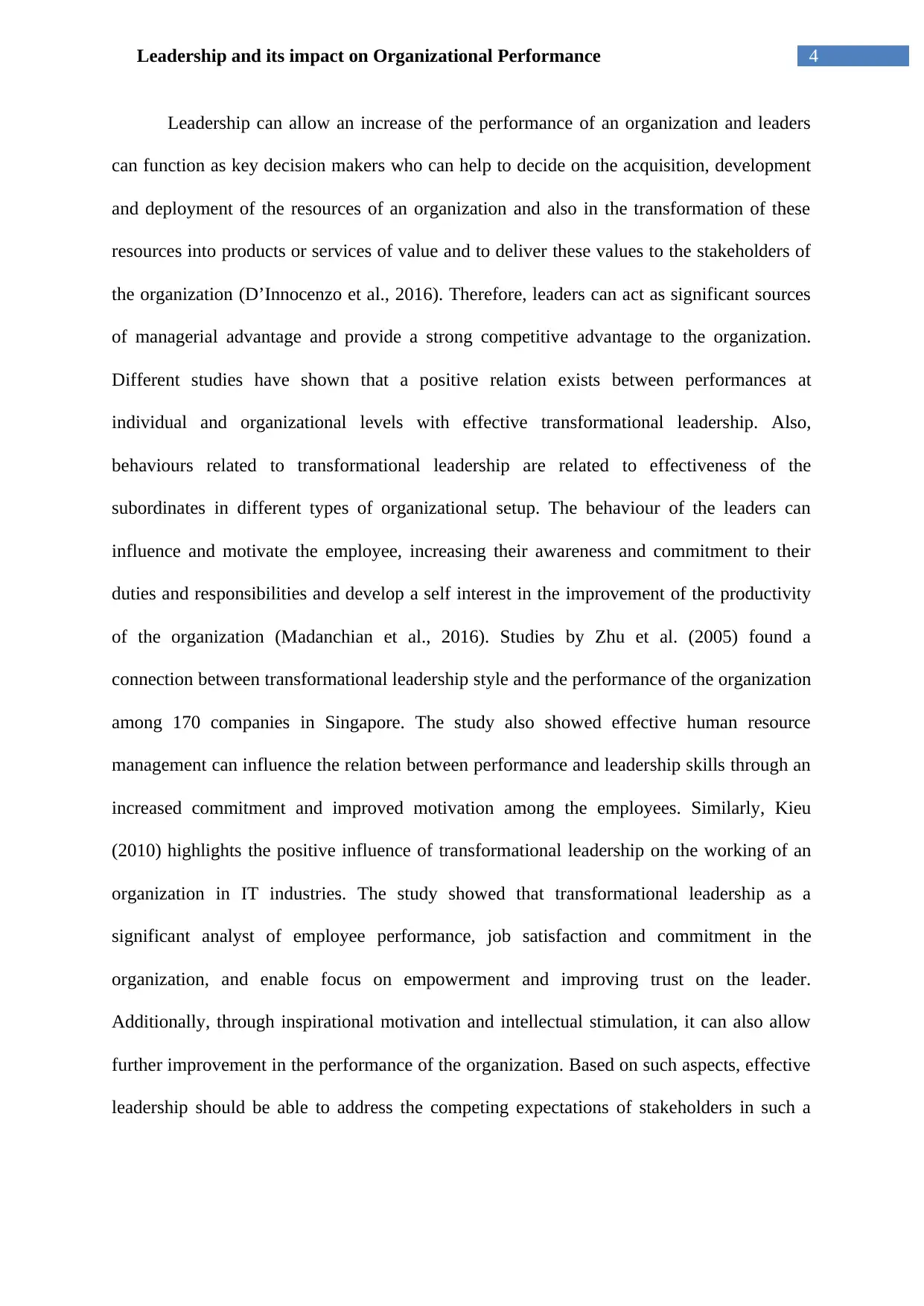
4Leadership and its impact on Organizational Performance
Leadership can allow an increase of the performance of an organization and leaders
can function as key decision makers who can help to decide on the acquisition, development
and deployment of the resources of an organization and also in the transformation of these
resources into products or services of value and to deliver these values to the stakeholders of
the organization (D’Innocenzo et al., 2016). Therefore, leaders can act as significant sources
of managerial advantage and provide a strong competitive advantage to the organization.
Different studies have shown that a positive relation exists between performances at
individual and organizational levels with effective transformational leadership. Also,
behaviours related to transformational leadership are related to effectiveness of the
subordinates in different types of organizational setup. The behaviour of the leaders can
influence and motivate the employee, increasing their awareness and commitment to their
duties and responsibilities and develop a self interest in the improvement of the productivity
of the organization (Madanchian et al., 2016). Studies by Zhu et al. (2005) found a
connection between transformational leadership style and the performance of the organization
among 170 companies in Singapore. The study also showed effective human resource
management can influence the relation between performance and leadership skills through an
increased commitment and improved motivation among the employees. Similarly, Kieu
(2010) highlights the positive influence of transformational leadership on the working of an
organization in IT industries. The study showed that transformational leadership as a
significant analyst of employee performance, job satisfaction and commitment in the
organization, and enable focus on empowerment and improving trust on the leader.
Additionally, through inspirational motivation and intellectual stimulation, it can also allow
further improvement in the performance of the organization. Based on such aspects, effective
leadership should be able to address the competing expectations of stakeholders in such a
Leadership can allow an increase of the performance of an organization and leaders
can function as key decision makers who can help to decide on the acquisition, development
and deployment of the resources of an organization and also in the transformation of these
resources into products or services of value and to deliver these values to the stakeholders of
the organization (D’Innocenzo et al., 2016). Therefore, leaders can act as significant sources
of managerial advantage and provide a strong competitive advantage to the organization.
Different studies have shown that a positive relation exists between performances at
individual and organizational levels with effective transformational leadership. Also,
behaviours related to transformational leadership are related to effectiveness of the
subordinates in different types of organizational setup. The behaviour of the leaders can
influence and motivate the employee, increasing their awareness and commitment to their
duties and responsibilities and develop a self interest in the improvement of the productivity
of the organization (Madanchian et al., 2016). Studies by Zhu et al. (2005) found a
connection between transformational leadership style and the performance of the organization
among 170 companies in Singapore. The study also showed effective human resource
management can influence the relation between performance and leadership skills through an
increased commitment and improved motivation among the employees. Similarly, Kieu
(2010) highlights the positive influence of transformational leadership on the working of an
organization in IT industries. The study showed that transformational leadership as a
significant analyst of employee performance, job satisfaction and commitment in the
organization, and enable focus on empowerment and improving trust on the leader.
Additionally, through inspirational motivation and intellectual stimulation, it can also allow
further improvement in the performance of the organization. Based on such aspects, effective
leadership should be able to address the competing expectations of stakeholders in such a
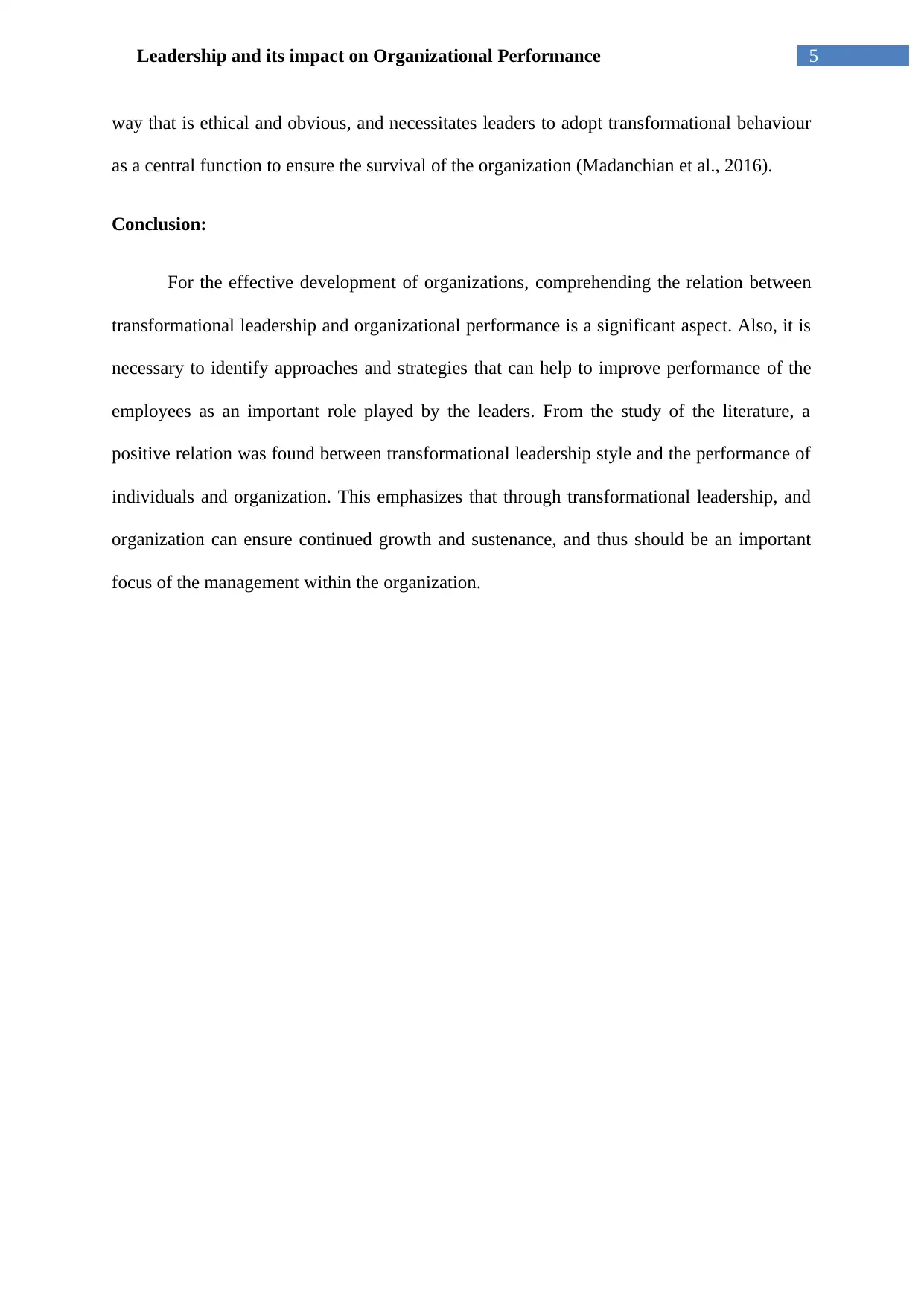
5Leadership and its impact on Organizational Performance
way that is ethical and obvious, and necessitates leaders to adopt transformational behaviour
as a central function to ensure the survival of the organization (Madanchian et al., 2016).
Conclusion:
For the effective development of organizations, comprehending the relation between
transformational leadership and organizational performance is a significant aspect. Also, it is
necessary to identify approaches and strategies that can help to improve performance of the
employees as an important role played by the leaders. From the study of the literature, a
positive relation was found between transformational leadership style and the performance of
individuals and organization. This emphasizes that through transformational leadership, and
organization can ensure continued growth and sustenance, and thus should be an important
focus of the management within the organization.
way that is ethical and obvious, and necessitates leaders to adopt transformational behaviour
as a central function to ensure the survival of the organization (Madanchian et al., 2016).
Conclusion:
For the effective development of organizations, comprehending the relation between
transformational leadership and organizational performance is a significant aspect. Also, it is
necessary to identify approaches and strategies that can help to improve performance of the
employees as an important role played by the leaders. From the study of the literature, a
positive relation was found between transformational leadership style and the performance of
individuals and organization. This emphasizes that through transformational leadership, and
organization can ensure continued growth and sustenance, and thus should be an important
focus of the management within the organization.
⊘ This is a preview!⊘
Do you want full access?
Subscribe today to unlock all pages.

Trusted by 1+ million students worldwide
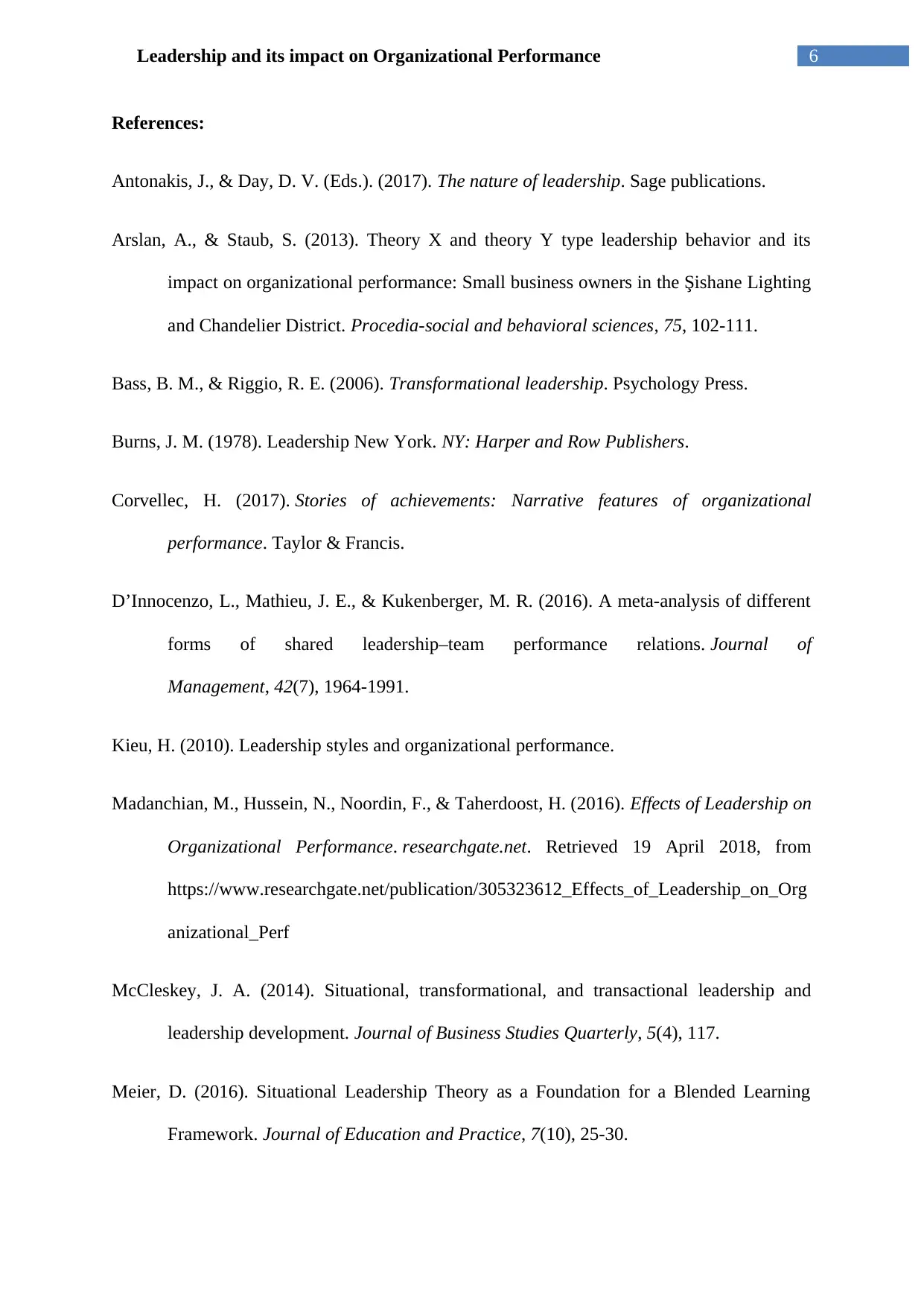
6Leadership and its impact on Organizational Performance
References:
Antonakis, J., & Day, D. V. (Eds.). (2017). The nature of leadership. Sage publications.
Arslan, A., & Staub, S. (2013). Theory X and theory Y type leadership behavior and its
impact on organizational performance: Small business owners in the Şishane Lighting
and Chandelier District. Procedia-social and behavioral sciences, 75, 102-111.
Bass, B. M., & Riggio, R. E. (2006). Transformational leadership. Psychology Press.
Burns, J. M. (1978). Leadership New York. NY: Harper and Row Publishers.
Corvellec, H. (2017). Stories of achievements: Narrative features of organizational
performance. Taylor & Francis.
D’Innocenzo, L., Mathieu, J. E., & Kukenberger, M. R. (2016). A meta-analysis of different
forms of shared leadership–team performance relations. Journal of
Management, 42(7), 1964-1991.
Kieu, H. (2010). Leadership styles and organizational performance.
Madanchian, M., Hussein, N., Noordin, F., & Taherdoost, H. (2016). Effects of Leadership on
Organizational Performance. researchgate.net. Retrieved 19 April 2018, from
https://www.researchgate.net/publication/305323612_Effects_of_Leadership_on_Org
anizational_Perf
McCleskey, J. A. (2014). Situational, transformational, and transactional leadership and
leadership development. Journal of Business Studies Quarterly, 5(4), 117.
Meier, D. (2016). Situational Leadership Theory as a Foundation for a Blended Learning
Framework. Journal of Education and Practice, 7(10), 25-30.
References:
Antonakis, J., & Day, D. V. (Eds.). (2017). The nature of leadership. Sage publications.
Arslan, A., & Staub, S. (2013). Theory X and theory Y type leadership behavior and its
impact on organizational performance: Small business owners in the Şishane Lighting
and Chandelier District. Procedia-social and behavioral sciences, 75, 102-111.
Bass, B. M., & Riggio, R. E. (2006). Transformational leadership. Psychology Press.
Burns, J. M. (1978). Leadership New York. NY: Harper and Row Publishers.
Corvellec, H. (2017). Stories of achievements: Narrative features of organizational
performance. Taylor & Francis.
D’Innocenzo, L., Mathieu, J. E., & Kukenberger, M. R. (2016). A meta-analysis of different
forms of shared leadership–team performance relations. Journal of
Management, 42(7), 1964-1991.
Kieu, H. (2010). Leadership styles and organizational performance.
Madanchian, M., Hussein, N., Noordin, F., & Taherdoost, H. (2016). Effects of Leadership on
Organizational Performance. researchgate.net. Retrieved 19 April 2018, from
https://www.researchgate.net/publication/305323612_Effects_of_Leadership_on_Org
anizational_Perf
McCleskey, J. A. (2014). Situational, transformational, and transactional leadership and
leadership development. Journal of Business Studies Quarterly, 5(4), 117.
Meier, D. (2016). Situational Leadership Theory as a Foundation for a Blended Learning
Framework. Journal of Education and Practice, 7(10), 25-30.
Paraphrase This Document
Need a fresh take? Get an instant paraphrase of this document with our AI Paraphraser

7Leadership and its impact on Organizational Performance
Miner, J. B. (2015). Organizational behavior 1: Essential theories of motivation and
leadership. Routledge.
Northouse, P. G. (2018). Leadership: Theory and practice. Sage publications.
Zhu, W., Chew, I. K., & Spangler, W. D. (2005). CEO transformational leadership and
organizational outcomes: The mediating role of human–capital-enhancing human
resource management. The leadership quarterly, 16(1), 39-52.
Miner, J. B. (2015). Organizational behavior 1: Essential theories of motivation and
leadership. Routledge.
Northouse, P. G. (2018). Leadership: Theory and practice. Sage publications.
Zhu, W., Chew, I. K., & Spangler, W. D. (2005). CEO transformational leadership and
organizational outcomes: The mediating role of human–capital-enhancing human
resource management. The leadership quarterly, 16(1), 39-52.
1 out of 8
Related Documents
Your All-in-One AI-Powered Toolkit for Academic Success.
+13062052269
info@desklib.com
Available 24*7 on WhatsApp / Email
![[object Object]](/_next/static/media/star-bottom.7253800d.svg)
Unlock your academic potential
Copyright © 2020–2025 A2Z Services. All Rights Reserved. Developed and managed by ZUCOL.





